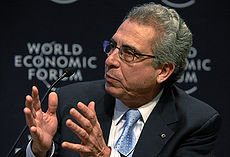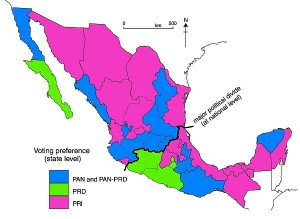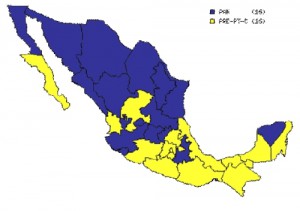President Ernesto Zedillo (in office from 1994 to 2000) took unprecedented steps that set the stage for Mexico’s 21st century economy. Before discussing Zedillo’s economic reforms, it is useful to review the recent history of Mexico’s economy.
 Following the fifty year “Mexican Miracle” of unprecedented economic growth and low inflation, the economy entered some very tough times in the early 1980s. Assuming high oil prices would continue, Mexico borrowed very heavily and could not pay its debts when oil prices plunged in 1981-82 and interest rates rose dramatically. The government suspended debt payments, devalued the peso by 500%, and nationalized the banks. The “lost decade” of the 1980s was an economic disaster, with inflation rates over 100% and economic growth hovering around 1%.
Following the fifty year “Mexican Miracle” of unprecedented economic growth and low inflation, the economy entered some very tough times in the early 1980s. Assuming high oil prices would continue, Mexico borrowed very heavily and could not pay its debts when oil prices plunged in 1981-82 and interest rates rose dramatically. The government suspended debt payments, devalued the peso by 500%, and nationalized the banks. The “lost decade” of the 1980s was an economic disaster, with inflation rates over 100% and economic growth hovering around 1%.
Economic growth improved a bit the early 1990s but President Salinas was forced to introduce strict price controls in an attempt to curb inflation. With a fixed exchange rate, the peso soon became severely overvalued. Then in January 1994, Zapatistas in Chiapas rebelled against the national government. Two month later, PRI Presidential candidate Donaldo Colosio was assassinated in Tijuana. Salinas selected as his replacement, Colosio’s campaign manager and technocrat Ernesto Zedillo, a Yale PhD Economist who had previously been a university professor, Minister of Planning and Budget as well as Minister of Education. Zedillo easily won the relatively fair 1994 election and was called the “accidental president” because he never sought the presidency and never previously held elected office.
Upon assuming office, Zedillo faced an impending severe economic crisis. As was customary, Salinas in his last year had spent very lavishly, severely aggravating the government deficit. The economic crisis of 1995 was characterized by a deep recession, hyperinflation, widespread bankruptcies, serious unemployment and soaring interest rates. He floated the peso which quickly moved from 4.0 to 7.2 to the US dollar.
President Clinton orchestrated a controversial $48 billion bail-out loan which eased the crisis. Conditions of the loan required very stiff and unpopular austerity measures including a 50% income tax hike, reduced public spending, privatizing some state-owned enterprises, and making the Central Bank of Mexico more independent from politics. Zedillo effectively implemented these reforms, knowing they were the best for Mexico’s future though they seriously hurt his public popularity.
The bailout reforms succeeded, the economy stabilized and began to grow, averaging over 5% between 1996 and 2000. Mexico repaid the bailout loan three years before its due date. During the crisis and throughout his term, Zedillo supported and expanded Mexico’s free trade (globalization) agenda.
The Mexican economy is now far more stable than is was in the years prior to the Zedillo reforms. Mexico appears to be completely beyond the self-inflicted economic crises it experienced in the late 20th century. The 2008-09 recession was serious but was completely beyond the control of Mexico. The Mexican economy appears to be recovering nicely in 2010.
Chapters 14 through 20 of Geo-Mexico: the geography and dynamics of modern Mexico discuss the components and characteristics of Mexico’s economy. Buy your copy today to have a handy reference guide to all major aspects of Mexico’s geography!


